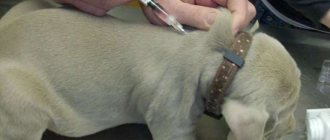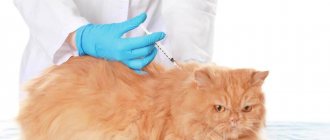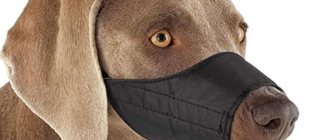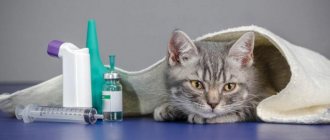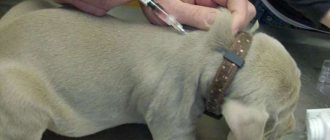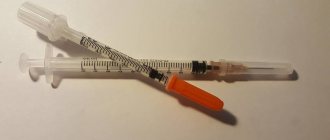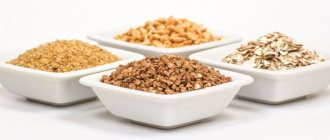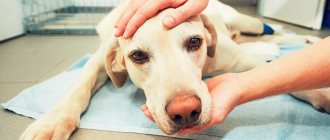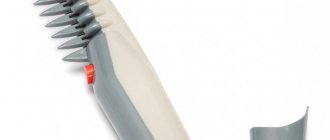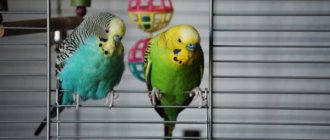Vaccination protects against infections that can lead to the death of the animal. These include several diseases, in particular rabies and leptospirosis, which are also dangerous to humans. But the dog owner does not always have the opportunity to visit a veterinary clinic. In such cases, you need to know how to vaccinate a dog yourselfto protect it from dangerous viruses and bacteria.
Vaccinations protect against rabies and other infections
Vaccination schedule
Vaccination is carried out according to a specific schedule.
Table 1. Recommended vaccination schedule for dogs
| 8-9 weeks | Vaccination against canine distemper, parvovirus enteritis, infectious hepatitis, adenovirus infection, parainfluenza, leptospirosis. |
| 12 weeks | Revaccination against canine distemper, parvovirus enteritis, infectious hepatitis, adenovirus infection, parainfluenza, leptospirosis, rabies. |
| After changing teeth | Vaccination against canine distemper, parvovirus enteritis, infectious hepatitis, adenovirus infection, parainfluenza, leptospirosis, rabies. |
| 1 year | Vaccination against canine distemper, parvovirus enteritis, infectious hepatitis, adenovirus infection, parainfluenza, leptospirosis, rabies. |
| Annually | Revaccination (canine distemper, parvovirus enteritis, infectious hepatitis, adenovirus infection, parainfluenza, leptospirosis, rabies). |
Attention! Some manufacturers produce vaccines that guarantee protection of the animal from viruses and infections for 3 years. Accordingly, they are administered once every 3 years.
Vaccination is carried out according to a specific schedule
In Russia, dogs are vaccinated against borreliosis and bordetellosis, the causative agents of tracheobronchitis (CB). Whether they are needed is decided by the doctor based on data on the epidemiological situation in the region.
The most common and dangerous diseases that dogs can get
The disadvantage of vaccinations at home is that this fact is not noted in documents - veterinary passports and specialized registers. Therefore, if we are talking about an animal that will travel or take part in exhibitions, then the procedure is carried out in a veterinary clinic. Previously, according to the law, rabies vaccinations were allowed only in government clinics. Now private veterinary clinics are also given such powers.
It has not been proven that vaccination can protect a dog from shingles.
Dogs are also vaccinated against other diseases - parasitic infestations, coronavirus, lichen. But their effectiveness is either low or not proven.
Attention! When choosing a drug, remember its name and manufacturer. Veterinarians recommend vaccinating an animal with the same vaccine throughout its life.
Main stage
During immunization, the rules of asepsis and antiseptics are observed. Use gloves to protect the skin of your hands from possible contact with the product. They put a muzzle on the animal; if it is aggressive, they call a second person to help, who will secure the dog for the duration of the injection. The bottle of medicine is taken out of the refrigerator in advance and kept until a comfortable temperature is reached.
Next, follow the following sequence:
- preparing the composition. For example, the rabies vaccine is available in two derivatives. Before the injection, mix the liquid component with the dry substance to obtain a single dose of the drug. First, the liquid substance is drawn into the syringe, having previously treated the cap with alcohol, then the needle is inserted through the cap into the bottle with the dry component, waiting for complete dissolution and homogeneity of the liquid;
- draw the injection suspension into a syringe, it is advisable to take a new syringe;
- get rid of air. You can do it like this. You will need to take the syringe vertically, press the plunger until liquid flows out of the spout, you can tap the syringe a little, then the bubbles will concentrate together and it will be easier to remove them;
- fix the dog, spread the fur on the withers, wipe the skin with an alcohol solution;
- pull back the skin at the withers, insert a needle 1.5 cm;
- The dog is vaccinated subcutaneously; if administered correctly, the pet will not feel pain. Some drugs are administered intramuscularly, and not at the withers. In such cases, you will need to determine the muscle, having first checked the information with veterinarians, or, in extreme cases, on the Internet;
- knead the injection area, treat again with alcohol;
- stick labels from the bottle into a notebook and indicate the date of re-vaccination;
- Dispose of the vials and the remaining substance.
Read. Vaccinations and vaccination of cats against lichen
Further caring for the dog comes down to monitoring its behavior. Severe reactions may appear in the first hour after the injection. Breathing problems, increased swelling, and anxiety will require going to the clinic and using medications.
Vaccines
In veterinary practice, the following brands of vaccines are used to vaccinate dogs:
- Nobivac;
- Duramun;
- Eurikan;
- Biovac;
- Dipentavak;
- Asterion;
- Multikan and others.
Basically, these are complex products that contain causative agents of major infections, some of them including the rabies virus. The latter include Asterion DHPPiR, Multikan-8.
Attention! Not all domestic vaccines are recognized abroad. Therefore, it is necessary to consult a veterinarian about the drug if you are planning a trip accompanied by an animal.
Decoding the letter values in the names of the product
Vaccines are either live or inactivated. Not all specialists use inactivated products. According to some doctors, they provide weaker immune protection, so preference should be given to “live” formulations.
How the vaccine is administered
It is better to get vaccinated in the morning on a day off. This makes it possible to monitor the dog’s condition all day long.
You can read about how to prepare your dog for vaccination, what to do if complications arise and where is the best place to vaccinate in our article.
Typically, the kit includes two products: the vaccine itself in powder form and a solvent for it. The components are first mixed. To do this, draw up the solvent with a syringe, and then inject it with a needle through the lid into the container with the powder. The mixture is thoroughly shaken until all dry particles are dissolved. Select the injection site:
- subcutaneously - withers area;
- intramuscularly - thigh area.
Place of injection - withers area
Next, the drug is administered into the dog’s body in the following order:
- treat the injection site (if necessary, cut it with scissors);
- wipe the injection site with medical alcohol;
- immobilize the animal using a special bag, towel, or ask another family member to hold it;
- if the injection is given at the withers, a fold of skin is collected on this part, into the base of which a needle is inserted;
- the drug is infused;
- remove the syringe;
- wipe the injection site with alcohol.
The instructions for some drugs say that the injection site must be massaged. More precise instructions regarding the rules and method of administration should be sought in the manufacturer's instructions.
Intranasal vaccines (for example, Nobivac KS) are administered into the nostril. Then the drug is poured into the nasal passage.
Video - How the vaccine is administered
The vaccine should not be used in the following cases:
- bottles or caps are damaged;
- the product has expired;
- the liquid or powder looks different from the description in the instructions.
Personal safety measures
The vaccine spilled on the body is washed off with plenty of running water. If a veterinary drug is accidentally administered to a person, then in such cases, immediately consult a doctor. The specialist is presented with a factory-made vaccine bottle.
Any drug that gets on the skin is washed off with plenty of running water.
The drugs are stored in places inaccessible to children. After use, the product is immediately discarded so as to prevent other animals or people from reaching the containers and used syringes.
First vaccination
The first vaccine is administered twice, regardless of the dog’s age, according to the following scheme:
- Anthelmintic drug - 2 times with an interval of 2 weeks.
- The first vaccination is after 1.5-2 weeks of the second dose of anthelmintic.
- The second vaccination is 3 weeks after the first.
Attention! Re-vaccination is carried out with the same drug with the same quantity and qualitative composition of strains. Using another drug may be dangerous to your pet's health.
Contraindications to vaccination
Vaccinations are given when the dog is healthy. This is important because vaccination puts a strain on the immune system. The body must respond correctly to the substance and fully produce antibodies.
Vaccinations are prohibited for dogs with the following conditions:
- infection with worms;
- illness, including one suffered shortly before;
- exhaustion;
- change of teeth in a puppy.
Also, you cannot plan to administer the vaccine 2 weeks before and after the cupping procedure.
Attention! The body must first be cleared of worms. Dogs are given medications two weeks before vaccination. Parasites reduce the effectiveness of the drug to zero.
Parasites are expelled before vaccination
Another contraindication is previous vaccination. The next one can be carried out no earlier than after 3 weeks.
If on the day of vaccination or one or two days before, the owner notices alarming symptoms in the pet, digestive disorders, changes in behavior, the procedure is postponed.
Subcutaneous injection
A hypodermic injection should be given to the dog at the withers.
- The withers are a small area of a dog's fur where the shoulder blades of the forelimbs meet.
- It is not difficult to find it, since in this place there is a small excess of skin into which the injection will need to be placed.
- Pull back the withers a little and carefully, gradually wind the syringe.
If everything is done correctly, the needle will enter without any problems and the liquid will flow out of it without any effort.
Pregnancy and lactation
It is recommended that your dog be vaccinated before pregnancy occurs. It is possible that vaccine components can penetrate the placenta and cause fetal death or developmental defects. If such a measure is necessary, it is recommended to use only inactivated drugs, which are selected by the veterinarian.
It makes no sense to vaccinate a nursing bitch to protect the offspring. In order for puppies to acquire passive immunity, the female’s body must begin to produce antibodies. To do this, at least a week must pass after the procedure. Antibodies are obtained from the mother through colostrum in the first 36 hours of the offspring's life.
It is better to vaccinate a bitch before pregnancy.
How much does it cost to give a dog an injection at home?
For the convenience of the owner and to minimize stress for the dog, many veterinary clinics have introduced the service of calling a doctor or procedural nurse to your home.
The price of arrival is on average 500-1000 rubles . One subcutaneous injection - 100-300 rubles , intramuscular - 200-300 rubles , intravenous - 500-700 rubles , dropper - 500-1000 rubles per hour , placement of an intravenous catheter - 300-600 rubles .
Consumables and medications are paid separately. If you have your own medications, it is better to notify the nurse about this in advance.
With the proper skills, intramuscular and subcutaneous injections are not a complicated procedure. After 3-4 injections you will feel confident and will be able to help your pet at home.
Features of puppy vaccination
Puppies that are breastfed acquire passive immunity from their mother, provided that she is vaccinated in a timely manner. The female passes antibodies to infections to the cubs with her milk. The time of the first vaccination depends on the quality of the mother's lactation. If there are few puppies, then vaccination is carried out no earlier than 10 weeks. Earlier introduction of complementary foods and a large litter are grounds for vaccination at an earlier age.
Puppies receive passive immunity from their vaccinated mother
Monitoring the dog's condition
After vaccination, it is necessary to monitor the animal’s condition for 2 weeks.
Some discomfort is considered normal
The following phenomena are considered normal:
- A lump or lump in the place where the drug was injected. The formation resolves within a month. If the lump increases in size, then this is a reason to consult a doctor.
- Vomiting, diarrhea, refusal to eat, if these phenomena were recorded once.
- Pain at the injection site.
- Lethargy, fever up to 39 °C.
Complications from vaccination
You should immediately contact your veterinarian in the following cases:
- loose stools and vomiting after administration of the drug were observed 2 or more times;
- the dog missed more than one meal;
- temperature above 39 °C;
- convulsions and drooling appeared;
- mucous membranes turned pale;
- swelling is noticeable;
- breathing became difficult and quickened.
Prolonged refusal to eat is a cause for concern
A painful reaction is provoked by various factors. Poor quality vaccine is one of them.
Allergy to the drug
An acute attack of allergy is observed in a dog 10–15 minutes after administration of the drug. This is the most dangerous reaction to the vaccine. The following symptoms may occur:
- behavior is disrupted - the animal becomes too excited or depressed;
- head temperature rises;
- the dog may suddenly relieve itself;
- the muzzle swells - eyes, nose, ears;
- saliva is produced abundantly;
- watery eyes or nasal discharge appears.
After administration of the drug, an acute allergic reaction is possible
You should always be prepared for such a reaction. Therefore, it is a good idea to ask your veterinarian which drug and in what dose should be administered in such cases. For severe allergies, solutions of Tavegil, Andrenalin or Suprastin are used. In case of anaphylactic shock, Dexamethasone is recommended, after which the pet is immediately shown to a doctor.
Video - Complication in a kitten after vaccination
To avoid an allergic reaction, the solution is administered fractionally: first a small dose, then the remaining drug in the syringe. Then the antibodies bind to a smaller portion of the solution, thereby reducing the severity of the reaction.
What is important to know before giving an injection
You need to prepare for any procedure, especially if you have no experience:
- You must have a doctor's prescription on hand indicating the dosage of the drug , where to inject the dog, the frequency and duration of use.
- Familiarize yourself with the features of the medicine . Some need to be shaken, for example, Sinulox, others require dilution, for example, Ceftriaxone.
- Drugs cannot be mixed in one syringe unless there are instructions from the doctor that this should be done, for example, it is permissible to inject Analgin, Diphenhydramine, No-shpu together at an elevated temperature.
- Injections are carried out with sterile syringes, new each time . This is due to the fact that even if you boil it, the needle will still be dull. It’s not for nothing that syringes are called disposable.
- Familiarize yourself with injection techniques . You can give an injection yourself at home intramuscularly, subcutaneously or intravenously.
- Select the correct syringe size . For subcutaneous injections, 1-2 ml are most often used, for intramuscular injections - 2-5 ml, for intravenous injections 10-20 ml.
- Before the injection, the animal's skin can be treated with an antiseptic . Ideal sterility is difficult to achieve, since there is fur all around. But your pet's skin has its own unique antimicrobial properties.
Don't forget about restraining the dog. If your pet flinches or runs, there is a risk that the medication may not be administered correctly or the needle may break.
Anatomy of a dog's muscles
There are several ways to prevent this:
- Fixation bag for small dogs up to 10 kg . It looks like a carrier; only the pet's head remains outside. There are several zippers; by unfastening one, you can remove the desired paw and give an injection. If you loosen the Velcro a little, it won’t be difficult to give a subcutaneous injection.
- If the pet reacts calmly to the procedures, then you need to wear a muzzle in any case, since the dog can react to pain and bite, even its beloved owner. This is a normal defensive reaction for the animal. After putting on the muzzle, the dog is in a standing position. One person holds the collar, the second gives the injection.
- Some dogs are more comfortable lying on their side. In this case, the muzzle will also come in handy and the one who performs the fixation should be on the side of the dog’s back and hold the front and back paws, which will be at the bottom. This way, the pet will not have a foothold, and he will not be able to jump, and at this time you will calmly give the injection.
Quarantine after the vaccine
After receiving the vaccine, the dog is kept in quarantine for 10–14 days to develop lasting immunity. They don’t refuse walks. But their duration is reduced to the minimum necessary, especially in unfavorable weather conditions, in order to prevent hypothermia. They try to exclude contacts with other animals, in particular stray ones. Physical activity is also limited.
Don't miss a walk during quarantine
Required documents
Citizens of the Russian Federation
- Passport of a citizen of the Russian Federation (to confirm personal data and registration in Moscow)
- SNILS
- Compulsory medical insurance policy (optional)
- Phone number linked to the State Services portal
For foreign citizens
- Citizen's passport (with translation)
- Registration in Moscow
- SNILS
- Phone number linked to the State Services portal or mos.ru
How to store the vaccine
When purchasing a drug, you must ask the pharmacy seller to provide instructions for it. Optimal storage conditions are indicated there.
Attention! The effectiveness of the procedure depends on whether the recommendations are followed. A vaccine that has been stored without temperature control is unsuitable for use.
Most of these products are stored at a temperature of 2...8 °C. Freezing ampoules is prohibited, since the properties are lost in the same way as when heated. To deliver the drug from the veterinary pharmacy to your home, special thermal container bags are used. Such products are on sale. Some pharmacies rent bags with a deposit. To ensure the safety of the drug, some kind of refrigerant is placed inside - “dry ice”, ice cream, a bottle of frozen water.
Special container bags are used for delivery
A low-quality vaccine is always dangerous. In the “best” case, it will turn out to be plain water without a therapeutic effect. This will not harm the animal, but the body will not receive immunity to the infection. In the worst case, it will cause an allergic reaction and lead to death.
Preparing your pet for drug administration
Some animals hardly notice the injection, others behave restlessly or aggressively. In this case, it is worth calming the pet with conversation and stroking. In some cases, it is better to use a muzzle or a special restraint bag for miniature breeds.
Let your pet get used to the syringe. Fill it with a dose of medicine and give it a sniff. Be careful that the animal does not injure itself with the needle, keep the cap closed. You may not be able to smell the liquid, but trust me, your dog can!
Once you are sure that your pet is calm, it is time to give the injection.
If your dog has had injections before, he probably associates syringes with pain and discomfort. To combat this, give treats and use other forms of positive reinforcement such as praise and games.
Infection of a vaccinated animal
Vaccination does not provide a 100% guarantee that the vaccinated animal will not get sick. Infection occurs for the following reasons:
- low quality vaccine used;
- the storage conditions of the drug were violated;
- the solution was introduced incorrectly;
- the effect of the vaccine is suppressed by antibodies contained in the mother’s milk;
- there are other diseases, especially those associated with decreased immunity;
- the animal is infected with a large dose of the pathogen, the likelihood of such a scenario increases if this happened during the formation of immunity);
- the disease developed before immunity was formed.
However, such adverse events are rarely recorded.
Vaccination notes in the veterinary passport

